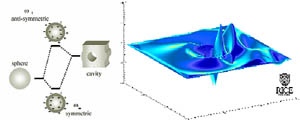New insight into nanoscale optics
New research from Rice University has
demonstrated an important analogy between electronics and optics that will
enable light waves to be coupled efficiently to nanoscale structures and
devices.

New research from Rice University has demonstrated an important analogy between electronics and optics that will enable light waves to be coupled efficiently to nanoscale structures and devices.
"We've discovered a universal relationship between the behavior of light and electrons," said study co-author Peter Nordlander, professor of physics and astronomy and of electrical and computer engineering. "We believe the relationship can be exploited to create nanoscale antennae that convert light into broadband electrical signals capable of carrying approximately 1 million times more data than existing interconnects."
Both light and electrons share similar properties, at times behaving like waves, at other times like particles. Many interesting solid-state phenomena, such as the scattering of atoms off surfaces and the behavior of quantum devices, can be understood as wavelike electrons interacting with discrete, localized electrons. Now, Rice researchers have discovered and demonstrated a simple geometry where light behaves exactly as electrons do in these systems.
I wish I could live another 100 years just to experience how and where some of this basic research ends up!
In recent years there has been intense interest in developing ways to guide and manipulate light at dimensions much smaller than optical wavelengths. Metals like gold and silver have ideal properties to accomplish this task. Special types of light-like waves, called plasmons, can be transmitted along the surfaces of metals in much the same way as light in conventional optical fibers.
When small metallic nanoparticles are positioned on the metal film, they behave like tiny antennae that can transmit or receive light; it is this behavior that has been found to mimic that of electrons. Until now, the coupling of light waves into extended nanoscale structures has been poorly understood.
Posted: Thu - September 15, 2005 at 12:10 PM